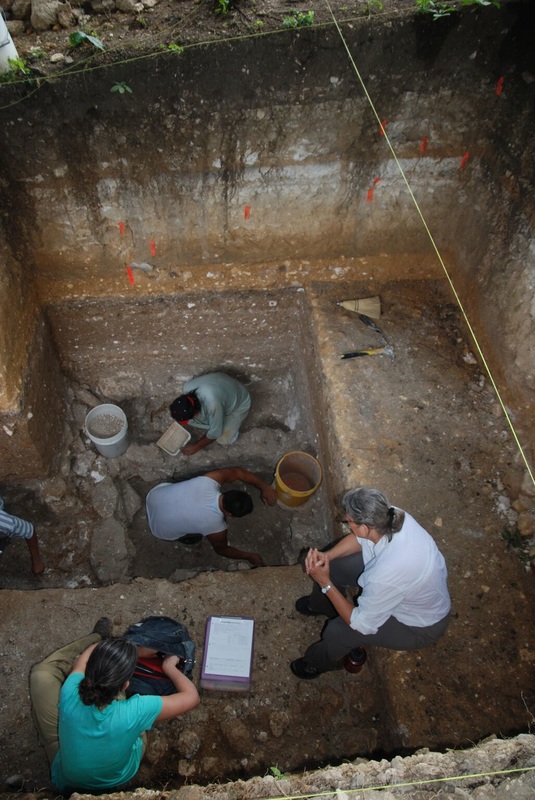The Actuncan Archaeological Project
The Actuncan Archaeological Project examines processes that led to the rise and fall of lowland Maya kingship at the site of Actuncan during its long 2,000 year history from the Preclassic (1000 B.C. to A.D. 300) to the Classic (A.D. 300 to 1000) periods. Although most archaeologists acknowledge that a suite of causal factors brought about centralized authority among the ancient Maya, the current debate is polarized between materialistic and ideational approaches. To move beyond these arguments, the project investigates relationships between leaders and non-ruling households to understand how bottom-up processes such as household cooperation and competition and top-down policies surrounding collective action led to variation in authority across time and place in the Maya lowlands.
FundingFunding for the Actuncan Archaeological Project has been provided by National Science Foundation (Grant BCS-0923747), National Geographic Society-Committee for Research and Exploration (9279-13, 9658-15), Heinz Foundation, and The University of Alabama’s College of Arts and Sciences, College Academy of Research, Scholarship, and Creative Activity (CARSCA), Advisory Committee (RAC), and Department of Anthropology awarded to LeCount. Other funds include National Science Foundation (BCS-1418480 awarded to Fulton), the Wenner-Gren Foundation for Anthropological Research and the Washington University Graduate School of Arts and Sciences (awarded to Mixter), University of California San Diego Center for Iberian and Latin American Studies and the Tinker Foundation (awarded to Bussiere) and a University of Alabama RAC to Blitz. We also wish to thank our anonymous private donors.
Project MembersThe project also supports independent research by Ph.D. candidates and professors including:
|
Annual Field Reports |
Theses and Dissertations
Tidwell, Wade. 2020. Archaeological Investigations of Magnetic Anomalies in the Northern Settlement Area at Actuncan, Belize. Unpublished Masters Thesis, Department of Anthropology, The University of Alabama, Tuscaloosa.
Heindel, Theresa. 2019. Plotting, Planting and Prospering: Ancient Maya Agricultural Production and Water Management at Actuncan, Belize. Unpublished Ph.D. Dissertation, Department of Anthropology, University of California, Riverside.
Lawhon, Taylor. 2018. The Classic Maya Palace Complex at Actuncan, Belize: A Functional Analysis of Room Architecture and Ceramic Assemblages. Unpublished Masters Thesis, Department of Anthropology, The University of Alabama, Tuscaloosa.
Mixter, David W. 2016. Surviving Collapse: Collective Memory and Political Reorganization at Actuncan, Belize. Unpublished PhD Dissertation, Department of Anthropology, Washington University in St. Louis.
Fulton, Kara A. 2015. Community Identity and Social Practice during the Terminal Classic Period at Actuncan, Belize. Unpublished PhD Dissertation, Department of Anthropology, University of South Florida, Tampa, FL.
Koenig, Emma N. 2014 Terminal Ritual Deposits and Abandonment Processes at Aguacate Uno, Belize. Unpublished Masters Thesis, Department of Anthropology, The University of Alabama, Tuscaloosa.
Simova, Borislava S. 2013. Identity Formation among the Ancient Maya as Reconstructed from Late Preclassic to Early Classic Domestic Contexts at the Site of Actuncan, Belize. Unpublished Masters Thesis, Department of Anthropology, The University of Alabama, Tuscaloosa.
Shults, Sara C. 2012. Uncovering Ancient Maya Exchange Networks: Using the Distributional Approach to Interpret Obsidian Exchange at Actuncan, Belize. Unpublished Masters Thesis, Department of Anthropology, The University of Alabama, Tuscaloosa.
Garcia, Krista L. 2008. Maya Pottery Specialization and Standardization: Using Late and Terminal Classic Ceramics from the Upper Belize River Valley to Evaluate Market Exchange. Unpublished Masters Thesis, Department of Anthropology, The University of Alabama, Tuscaloosa.
Heindel, Theresa. 2019. Plotting, Planting and Prospering: Ancient Maya Agricultural Production and Water Management at Actuncan, Belize. Unpublished Ph.D. Dissertation, Department of Anthropology, University of California, Riverside.
Lawhon, Taylor. 2018. The Classic Maya Palace Complex at Actuncan, Belize: A Functional Analysis of Room Architecture and Ceramic Assemblages. Unpublished Masters Thesis, Department of Anthropology, The University of Alabama, Tuscaloosa.
Mixter, David W. 2016. Surviving Collapse: Collective Memory and Political Reorganization at Actuncan, Belize. Unpublished PhD Dissertation, Department of Anthropology, Washington University in St. Louis.
Fulton, Kara A. 2015. Community Identity and Social Practice during the Terminal Classic Period at Actuncan, Belize. Unpublished PhD Dissertation, Department of Anthropology, University of South Florida, Tampa, FL.
Koenig, Emma N. 2014 Terminal Ritual Deposits and Abandonment Processes at Aguacate Uno, Belize. Unpublished Masters Thesis, Department of Anthropology, The University of Alabama, Tuscaloosa.
Simova, Borislava S. 2013. Identity Formation among the Ancient Maya as Reconstructed from Late Preclassic to Early Classic Domestic Contexts at the Site of Actuncan, Belize. Unpublished Masters Thesis, Department of Anthropology, The University of Alabama, Tuscaloosa.
Shults, Sara C. 2012. Uncovering Ancient Maya Exchange Networks: Using the Distributional Approach to Interpret Obsidian Exchange at Actuncan, Belize. Unpublished Masters Thesis, Department of Anthropology, The University of Alabama, Tuscaloosa.
Garcia, Krista L. 2008. Maya Pottery Specialization and Standardization: Using Late and Terminal Classic Ceramics from the Upper Belize River Valley to Evaluate Market Exchange. Unpublished Masters Thesis, Department of Anthropology, The University of Alabama, Tuscaloosa.


